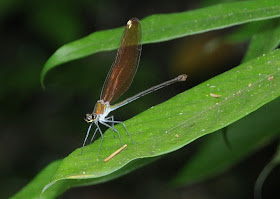Some years ago, I wrote a book called "Songbirds: Celebrating Nature's Voices", in which I extolled the virtues of being a "bird noticer". Since then I, with many other naturalists, have become, in addition, a Dragonfly Noticer, aided by an increasing range of field guides for various regions of the world. One of the joys of noticing dragonfly diversity is that familiar areas become, suddenly, new again.

I have already posted numbers of dragonfly photos on this blog, taken in a variety of (for me) exotic regions of the world. It is a pleasure, therefore, for me to present some dragonflies, every bit as new to me as their cousins in Borneo or China, that I encountered in my own home province of Ontario - including this charming little insect, a male White-faced Meadowhawk (Sympetrum obtrusum).

I met these insects around the ponds and lakes of cottage country in July 2010: specifically, near the cottage of our friend Robert Terro in Eagle Lake, Haliburton County, not far south of Algonquin Provincial Park. Our visit gave me the chance to test a new and excellent field guide, Field Guide to the Dragonflies of Algonquin Provincial Park and the Surrounding Area, against my very limited skills at dragonfly identification. White-faced Meadowhawks were common, and good to practice on.
Meadowhawks (or darters, if you're British) are found around the world in the temperate Northern Hemisphere. There are some fifty species altogether (fifteen in north America), and the few in Ontario can be very tricky to identify (if not impossible for juveniles without a specimen in hand). Thus, this male could be a Ruby Meadowhawk (Sympetrum rubicundum), because it seems to lack a white face, but I would hate to bet on it. The Ruby Meadowhawk has, apparently, an amber patch at the base of the wing, which I think I can make out in this photograph.
The White-faced Meadowhawk isn't the only dragonfly with a white face. These are male Frosted Whitefaces (Leucorrhina proxima).
Perhaps the handsomest- and certainly the most ornate - dragonfly at Eagle Lake was the Calico Pennant (Celithemis elisa). Identifying it is easy, but sexing and aging it is a bit trickier. According to the guide, the key is the colour of the spots on the abdomen and of the stigma, the coloured area shaped like a grain of rice on the leading edge of each wing. If they are both yellow, as in this photograph, the dragonfly is a female.
Pennants with yellow spots and red stigmas are juvenile males, as I believe these are.
If the spots and stigmas are both red, as in this individual, you have an adult male Calico Pennant. See?
In the dark and handsome category is this male Slaty Skimmer (Libellula incesta), a fair-sized dragonfly (some 5 cm long) that I found coursing about near the lake shore. According to the very useful Bug Guide website, males defend territories along the shoreline of ponds, particularly in the morning.
I'm not entirely positive, but I believe these two dragonflies are Chalk-fronted Corporals (Ladona julia). The female is at the top; notice the small patch of black at the base of her hindwing.
These are Common Whitetails (Plathemis lydia), this time two females, each with three dark patches on each wing, and a male with one broad dark band, a smaller dark stripe near the wing base, and the chalky-white abdomen that gives him his name.
All the dragonflies so far have been members of the skimmer family (Libellulidae). Libellulids seem to be almost the only dragonflies I encounter (or at least get close enough to photograph) no matter where I am in the world. Here, though, to end this entry, is something different: a Lancet Clubtail (Gomphus exilis), a member of the family Gomphidae. Gomphids are easy to recognize because their eyes, which are much closer to normal size than the huge hemispheres of the libellulids, do not meet across the top of the head. Oddly enough, it is this lack of an extreme feature that makes gomphids, at least to me, rather exotic-looking. Or perhaps, to me, they are simply new.


















































